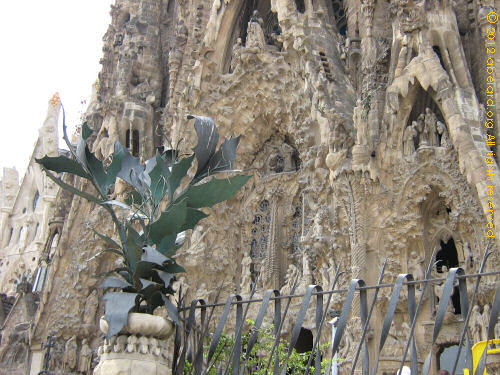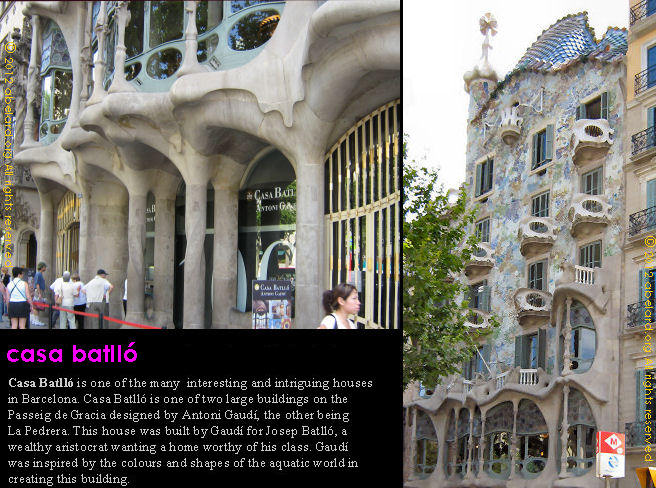










 |
 |
 |
 |
 |
 |
 |
||
| site map |  |
 |
 |
 |

|
Antoni
Gaudí: architecture in Barcelona, |
|
|
|
|
|||
|
Barcelona and Antoni Gaudí the Sagrada Família and Antoni Gaudí Barcelona and its art
a climber’s race - La Vuelta a Espana 2011 Vuelta a Espana, 2010 - an eco-tour
|
introduction
- antoni gaudí Antoni Gaudí i Cornet [1852 - 1926] Antoni Gaudí i Cornet was a Spanish architect
who designed and built many buildings in Barcelona. Gaudí
greatly influenced the city’s architecture, including
street furnishings and decoration; his work and influence
is now to be seen all around the city. Antoni Gaudí apparently was born in Reus in 1852. He studied architecture at the Llotja School and the Barcelona Higher School of Architecture, from where he graduated in 1878. From early on, his designs were stood apart from those of his contemporaries. |
||
|
|
|||
| Gaudí’s work was greatly influenced by forms in nature, reflected in the use of curved rounded stone construction, twisted iron sculptures and organic-like forms in their decoration. Gaudí also adorned many of his buildings with ceramic mosaics and tiling. This adds another dimension to his constructions, so often forgotten by other architects—the use of colour. His style is decorative and entertaining, making much use of ceramic mosaics, incorporating natural motifs and frequently avoiding straight lines and angles. All of these are traits of Gaudí’s Barcelona architecture. | |||
 Wrought ironwork and textured stone facade of the Sagrada Familia |
|||
This combination of design, original stone cutting and bright colours in the work of Gaudí is a breathtaking visual experience for the viewer. To give you an idea of his style, we show a selection of architectural works of Gaudí, describing further the Sagrada Familia on another page.
the sagrada famíliaThe Sagrada Família, started in 1915 and still to be completed, is an enormous, magnificent and idiosyncratic ecclesiastical building. This gigantic temple is probably one of the most impressive works of Antoni Gaudí and is the most visited attraction in all of Barcelona.
With its eighteen towers, currently still supplemented by soaring cranes and three enormous themed facades, the exterior of this huge basilica is breath-taking, and that is before even mounting the steps and entering the vast nave.
Parc Güell
Parc Güell was commissioned by Eusebi Güell to create a private park for the aristocracy of Barcelona. It is a magical creation of garden and buildings, absolutely fantastic sculptures and ceramics, all designed by Gaudí. There is also the architect’s former residence in the Parc Güell, now open to the public as a museum.
|
|
||
 |
|||
|
casa milà, or la pedrera (the quarry)
This Art Nouveau work is the largest civil building designed by Antoni Gaudí, and the second most popular building to visit in Barcelona. Casà Milà , an apartment block was commissioned by Roser Segimon and her second husband, Pere Milà, and constructed between 1906 and 1910. It was Gaudi’s last work prior to his monumental life’s work - the Sagrada Familia. Constructed entirely in natural stone, the vast Casa Milà is bereft of variation in colour and ornamentation. Its exterior has cliff-like walls with openings looking somewhat like troglodytes’ caves. This is the source of Casa Milà’s local nickname, the Quarry - La Pedrera. Inside and out, there are nothing but curves and arches, while the roof is supervised by ventilator and chimney guardians.
Seven of Gaudí’s works have been declared World Heritage Sites by UNESCO. The first six are all in Barcelona.
end notes
|
|
||
| abstracts | briefings | information | headlines | loud music & hearing damage | children & television violence | what is memory, and intelligence? | about abelard |
|
© abelard, 2012, 19 April the address for this document is https://www.abelard.org/spain/barcelona_antoni_gaudi.php |